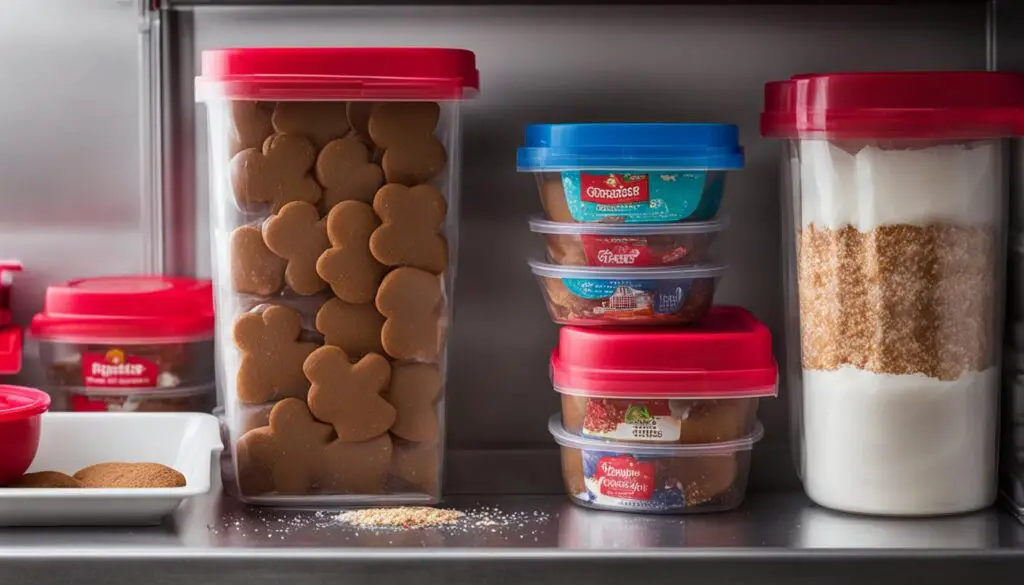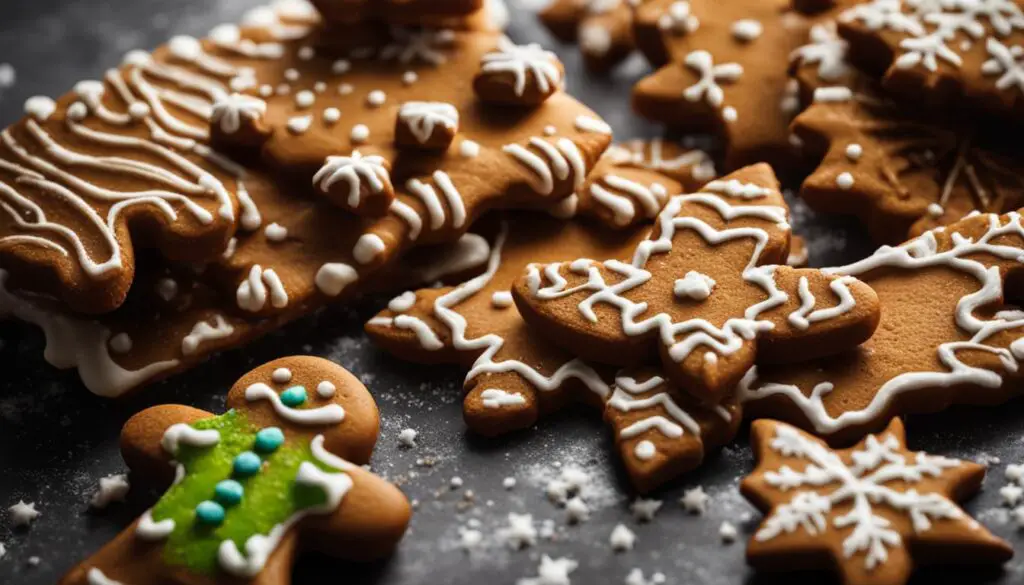Welcome to our guide on storing gingerbread dough! If you’re wondering how long gingerbread dough lasts in the fridge, you’ve come to the right place. Gingerbread is a delicious treat enjoyed during the holiday season, and knowing how to properly store it can help you enjoy it for as long as possible.
Proper storage is key to maintaining the freshness and flavor of gingerbread dough. Let’s dive into the details of gingerbread dough shelf life and the best practices for storing it in the refrigerator.
Key Takeaways:
- Gingerbread dough can last up to 7 days in the refrigerator when properly wrapped.
- Freezing fresh gingerbread dough extends its shelf life to up to 12 months.
- Pre-made gingerbread from a package can last about 7 days in the refrigerator but is not recommended for consumption.
- Pre-made gingerbread can last up to 10 months when stored in the freezer.
- Gingerbread houses have different expiration dates depending on whether they are unopened kits or decorated.
How Long Does Gingerbread Dough Last Once Made?
Gingerbread dough, whether homemade or pre-made, has a limited shelf life once it is made. The expiration date of gingerbread dough depends on the type of dough and the storage conditions. Homemade gingerbread dough can typically last up to 3 days in the refrigerator and up to 3 months in the freezer.
To ensure the freshness of gingerbread dough, it is important to wrap it tightly in plastic wrap or tin foil before storing it in the refrigerator or freezer. This helps to prevent air from entering and drying out the dough. Proper labeling with the date and contents is also beneficial for easy reference.
By following these storage guidelines, you can maximize the shelf life of your gingerbread dough and enjoy freshly baked gingerbread treats for longer periods of time.
How to Properly Store Gingerbread Dough
Preserving gingerbread dough is essential to maintain its freshness and quality. By following these gingerbread dough storage tips, you can ensure that your dough stays delicious and ready to use whenever you’re craving that warm, spicy flavor.
Wrap it Tight
One of the most important steps in storing gingerbread dough is to wrap it tightly. Use plastic wrap or tin foil to create an airtight seal around the dough. This will prevent air from entering and drying out the dough, keeping it moist and easy to work with. Remember to press the wrap directly onto the dough’s surface to minimize any potential exposure to air.
Choose the Right Container
Another effective storage method is to use a ziplock bag or an airtight container to store the gingerbread dough. These containers provide an extra layer of protection against air and moisture, helping to preserve the dough’s freshness. Make sure the container is clean and dry before placing the dough inside. Label the container with the date and its contents for easy reference.
Refrigerate or Freeze
Depending on how long you want to store your gingerbread dough, you can either refrigerate or freeze it. If you plan to use the dough within a week, refrigeration is sufficient. The dough can last for approximately a week in the refrigerator. However, if you want to extend its shelf life, freezing is the way to go. Frozen gingerbread dough can last for about three months, ensuring that you have dough readily available whenever you need it.

Remember, proper storage is key to preserving the freshness and quality of gingerbread dough. By wrapping it tightly, choosing the right container, and refrigerating or freezing it, you can enjoy delicious homemade gingerbread treats all year round.
How Do You Keep a Gingerbread House Fresh?
Keeping a gingerbread house fresh requires proper storage and protection. Once your gingerbread house is opened and decorated, it is recommended to store it in a plastic container to shield it from dust and ants. By storing it in a secure container, you can preserve its freshness and ensure its longevity as a decorative centerpiece.
If you plan on using the gingerbread house purely for decorative purposes, it is best to keep it at room temperature. This will maintain its texture and taste, allowing you and your guests to enjoy its aesthetic appeal for a longer period of time. Remember to keep it away from direct sunlight and excessive heat to prevent any melting or distortion.
“Storing the gingerbread house in a plastic container and keeping it at room temperature helps maintain its freshness and quality as a decorative centerpiece.”
However, if you have an unopened gingerbread house kit, it can be stored in the freezer for up to 12 months. Freezing preserves its freshness and prevents any potential spoilage. When you’re ready to use it, simply thaw it in the refrigerator overnight and assemble according to the instructions provided in the kit.
By following these storage tips, you can ensure that your gingerbread house remains fresh and visually appealing, allowing you and your loved ones to enjoy its beauty throughout the holiday season.
Does Gingerbread Go Bad?
Gingerbread can go bad if it is not stored properly or if it is past its expiration date. Signs of expired gingerbread include hardness, faint smell, discoloration, and the presence of mold. Moldy gingerbread should be thrown away to avoid any potential health risks. It is important to use common sense when determining if gingerbread has gone bad and to follow good storage practices to prolong its shelf life.
Proper storage involves wrapping gingerbread in plastic wrap or tin foil, placing it in an airtight container, and labeling it with the date and contents. If stored in the freezer, gingerbread can last for an extended period of time. However, it is advisable to consume gingerbread within a reasonable time frame to ensure its freshness and quality.
How Do You Know When Gingerbread Goes Bad?
There are several signs that can indicate when gingerbread has gone bad and is no longer safe to consume. It is important to be aware of these signs to avoid any potential health risks. Here are some key indicators:
- Hardness: Expired gingerbread will become extremely hard, making it difficult to enjoy. If the texture feels excessively firm or dry, it is a clear sign that the gingerbread has spoiled.
- Faint Smell: The typical aroma of gingerbread will diminish when it has gone bad. If the scent becomes weak or almost nonexistent, it is a strong indication that the gingerbread is no longer fresh.
- Discoloration: Gingerbread that has expired may change in color, becoming lighter and losing its rich, brown hue. If you notice any significant discoloration, it is best to discard the gingerbread.
- Presence of Mold: Mold growth on gingerbread is a clear indication that it has spoiled. If you see any visible mold or signs of mold, such as fuzzy patches or greenish-black spots, it is important to throw away the gingerbread to avoid potential health risks.
Remember to trust your senses and use common sense when assessing the freshness and edibility of gingerbread. If you notice any of these signs, it is best to err on the side of caution and discard the gingerbread to ensure your health and safety.

Proper Storage and Shelf Life
Proper storage is key to extend the shelf life of gingerbread and prevent it from going bad too quickly. Follow these guidelines to maximize the freshness of your gingerbread:
- Wrap gingerbread tightly in plastic wrap or tin foil to prevent air from entering and drying out the dough.
- Store the wrapped gingerbread in an airtight container or ziplock bag to provide an additional layer of protection against air and moisture.
- If you are refrigerating gingerbread, it can last for about a week. Freezing gingerbread can extend its shelf life to around 3 months.
- Label the container with the date and its contents to help you keep track of the storage duration.
By following these storage tips and being vigilant about the signs of spoiled gingerbread, you can enjoy your gingerbread creations while they are fresh and delicious.
What Happens When You Eat Bad Gingerbread?
Consuming expired or moldy gingerbread can pose potential health risks. Mold on gingerbread can produce harmful mycotoxins, which can be toxic when ingested. These mycotoxins can cause digestive problems, particularly in the intestines, if visible mold spores are consumed. Prolonged exposure to mycotoxins may also have long-term health effects.
It is important to be cautious and avoid eating moldy gingerbread to prevent these health risks. Moldy gingerbread should be discarded immediately. Always use common sense and trust your senses when assessing the freshness and quality of gingerbread before consumption.
To ensure your safety, it is advisable to follow proper storage practices and dispose of any gingerbread that shows signs of spoilage, such as hardness, faint smell, discoloration, or the presence of mold. Taking these precautions will help protect your health and ensure an enjoyable gingerbread experience.
FAQ
How long does gingerbread dough last in the fridge?
Gingerbread dough can last up to 3 days in the refrigerator.
How long does gingerbread dough last once made?
Generally, homemade gingerbread dough can last up to 3 days in the refrigerator and up to 3 months in the freezer.
How to properly store gingerbread dough?
To properly store gingerbread dough, wrap it tightly in plastic wrap or tin foil and place it in the refrigerator or freezer. Label the container with the date and contents for easy reference.
How do you keep a gingerbread house fresh?
If the gingerbread house is unopened, it can be stored in the freezer for up to 12 months. Once opened and decorated, it is recommended to store the gingerbread house in a plastic container to protect it from dust and ants.
Does gingerbread go bad?
Yes, gingerbread can go bad if it is not stored properly or if it is past its expiration date.
How do you know when gingerbread goes bad?
Signs of expired gingerbread include hardness, faint smell, discoloration, and the presence of mold.
What happens when you eat bad gingerbread?
Consuming bad gingerbread can have potential health risks, especially if it is moldy. Mold on gingerbread can produce mycotoxins, which are chemicals that are harmful to humans.
